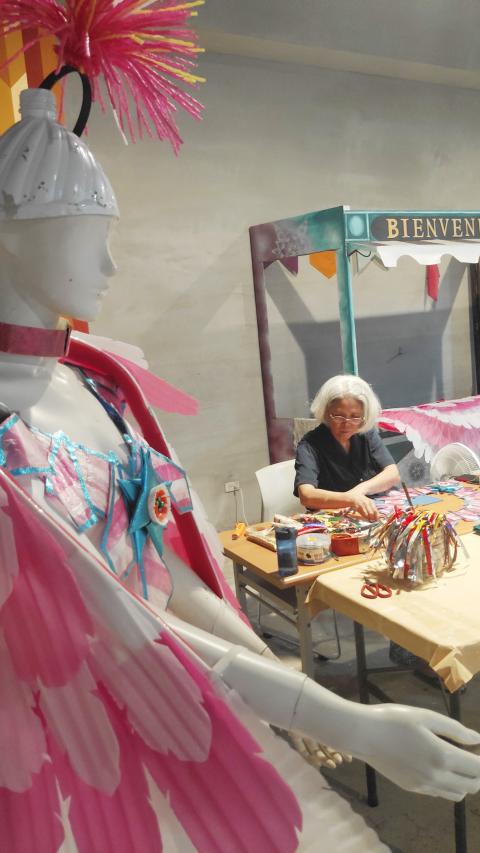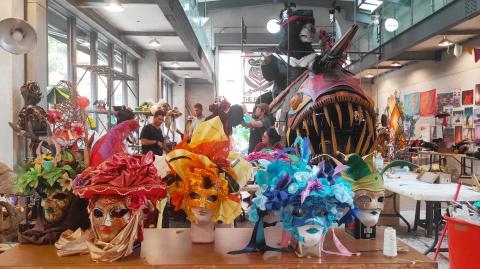When Yu Mei-ying (余美英) was tasked with making a samba costume with chicken elements, she headed to the local fruit stand instead of the craft store. She selected pink and white Styrofoam liners for the wings, and tore up the red and yellow fruit nettings for the crests.
“It took a while to collect all the materials for 13 costumes,” she says.
The retired insurance worker with no art background enthusiastically explains the materials used for the rest of the piece. The wings are supported by a used event banner and stitched together with paper bag handles, adorned with plastic bottle caps and Mardi Gras beads. The bottom piece is structured with a waistband made from drink cartons.

Photo: Han Cheung, Taipei Times
These costumes, as well as Yu’s other creations made from garbage bags, instant coffee packages, political campaign fans and broken umbrellas fit perfectly with the wildlife conservation and environmental protection theme at Saturday’s Dream Parade (夢想嘉年華).
The annual bash, put on by the Dream Community (夢想社區), will feature its usual samba drummers and dancers, stilt walkers, fire breathers, puppets, zany floats and lots of feathers, beads and glitter — as well as an emphasis on Taiwan’s endangered animals, such as the leopard cat, black bear, pangolin and humpback dolphin.
Partnering with the Taiwan Black Bear Conservation Association (台灣黑熊保育協會), this year’s extravaganza is a two-day affair that will include an animal conservation fair as well as a variety of performances on both Saturday and Sunday.

Photo: Han Cheung, Taipei Times
RECYCLED SAMBA
Yu first visited the Dream Community in April 2017 as a Neihu Community College volunteer because the artist community needed help making props for one of their artist events. Less than a month into retirement, Yu thought it would be beneficial to explore her passion in arts and crafts instead of “sitting at home all day.”
Dream Community staff noticed her enthusiasm, and invited her to stop by once a week to help repair the samba costumes for their annual parade. She ended up going there every day. Just a month into the endeavor, Dream Community founder Gordon Tsai (蔡聰明) informed Yu that a samba costume maker would be visiting the community soon, and asked if she wanted to learn from him.

Photo: Han Cheung, Taipei Times
“I would have to pay someone to teach me elsewhere, so I thought, why not?” Yu says.
Feeling ambitious, Yu wanted to make a costume before the maker arrived so he could appraise her skills.
“I’ve been looking at these costumes for a month. I thought I could put together something quickly,” she says confidently.
One day, someone brought in drink boxes for the artists and staff to enjoy. Recalling the MRT card holders she once made out of the cartons, Yu asked everyone to give her the boxes after they were done. Using red-and-white plastic bags as decoration, her first “recycled” samba costume was born.
Making a recycled costume is different from a traditional one. Glue guns, for example, cannot be used because they will melt the Styrofoam. Yu’s creations have to be adjustable without Velcro, and secure enough that they don’t fall apart when the wearer dances and prances during the parade. The cleanliness of the materials also matters — apple fruit meshes are generally less sticky and easier to sanitize than banana ones.
Yu asks if it’s okay that she is wearing her “rooster comb” on her head when posing for a photo with her costumes. As long as you feel comfortable, the photographer replies.
“Hey, if I was embarrassed by my creations, then nobody else would dare wear them,” she quips.
Those interested in making their own recycled costume can stop by the Dream Community this week from 10am to 6pm and speak to Yu. There will be material on site, but participants are encouraged to bring their own.
PIRATE BEAR
The rest of the Dream Community’s working space is right now buzzing with activity. International volunteers are helping the community’s resident artists, who have constructed impressive floats, costumes and props relating to this year’s theme.
The centerpiece of this year’s parade is a giant Formosan black bear pirate sitting on a monster fish float that has been repurposed from previous years. The bear is a bamboo and paper mache piece made by the community’s resident Balinese artists.
“I didn’t want to go with the traditional cartoon Formosan black bear,” parade art director Bridget Bell says, noting that instead of being cute and fluffy, black bears are actually dangerous if encountered in the wild. “It’s a creature that has been through so much. A pirate is a good representation of that. He’s missing an arm and a leg — it’s quite common for them to be trapped in the wild and lose a limb or two. It’s a reflection of the reality of the life of a black bear.”
Instead of a parrot, the pirate black bear has a chicken on its shoulder — inspired by the news story earlier this year where a Formosan black bear cub became attached to a chicken it was supposed to eat during preparations to release it back into the wild. There will also be a chicken float, which is why Yu was asked to make chicken-inspired designs.
In addition to all sorts of endangered endemic animals, a smaller, three-faced black bear creation also embodies the spirit of this year’s parade.
“The faces represent love, wisdom and strength,” Bell says. “That’s three characteristics we need to save the environment and help the animals.”

This month the government ordered a one-year block of Xiaohongshu (小紅書) or Rednote, a Chinese social media platform with more than 3 million users in Taiwan. The government pointed to widespread fraud activity on the platform, along with cybersecurity failures. Officials said that they had reached out to the company and asked it to change. However, they received no response. The pro-China parties, the Chinese Nationalist Party (KMT) and Taiwan People’s Party (TPP), immediately swung into action, denouncing the ban as an attack on free speech. This “free speech” claim was then echoed by the People’s Republic of China (PRC),

Exceptions to the rule are sometimes revealing. For a brief few years, there was an emerging ideological split between the Democratic Progressive Party (DPP) and Chinese Nationalist Party (KMT) that appeared to be pushing the DPP in a direction that would be considered more liberal, and the KMT more conservative. In the previous column, “The KMT-DPP’s bureaucrat-led developmental state” (Dec. 11, page 12), we examined how Taiwan’s democratic system developed, and how both the two main parties largely accepted a similar consensus on how Taiwan should be run domestically and did not split along the left-right lines more familiar in

Specialty sandwiches loaded with the contents of an entire charcuterie board, overflowing with sauces, creams and all manner of creative add-ons, is perhaps one of the biggest global food trends of this year. From London to New York, lines form down the block for mortadella, burrata, pistachio and more stuffed between slices of fresh sourdough, rye or focaccia. To try the trend in Taipei, Munchies Mafia is for sure the spot — could this be the best sandwich in town? Carlos from Spain and Sergio from Mexico opened this spot just seven months ago. The two met working in the

Many people in Taiwan first learned about universal basic income (UBI) — the idea that the government should provide regular, no-strings-attached payments to each citizen — in 2019. While seeking the Democratic nomination for the 2020 US presidential election, Andrew Yang, a politician of Taiwanese descent, said that, if elected, he’d institute a UBI of US$1,000 per month to “get the economic boot off of people’s throats, allowing them to lift their heads up, breathe, and get excited for the future.” His campaign petered out, but the concept of UBI hasn’t gone away. Throughout the industrialized world, there are fears that